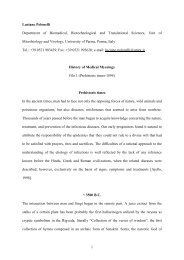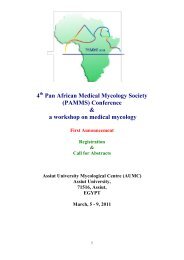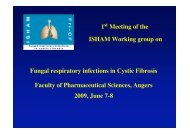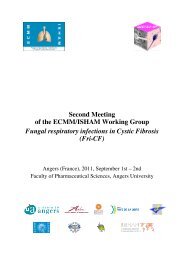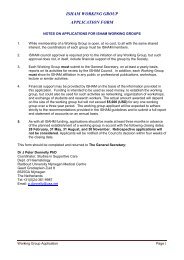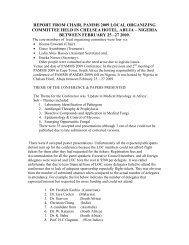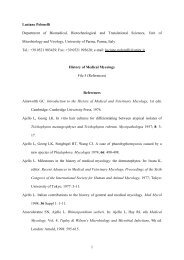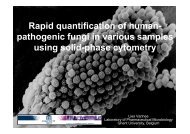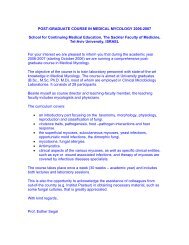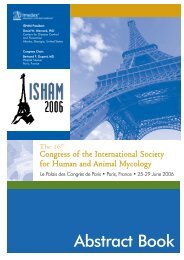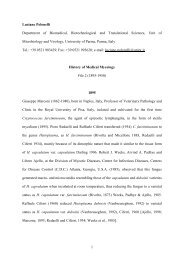Memoria CD.indd - ISHAM
Memoria CD.indd - ISHAM
Memoria CD.indd - ISHAM
Create successful ePaper yourself
Turn your PDF publications into a flip-book with our unique Google optimized e-Paper software.
Post-genomic contribution to the knowledge on thehost-pathogen interactionMaria Sueli Felipe, Aldo Henrique Tavares and Simoneide Souza SilvaInstituto de Ciências Biológicas, Universidade de Brasília, Brasília, DF, Brazil.e-mail : msueli@unb.br or msueliunb@gmail.comThe genome constitutes the informational core of all biological processes and the study of living organismsdepends heavily on our ability to access its contents. For many decades, the experimentalapproach consisted of isolating single genes or regulatory elements and characterizing each one ata time by means of loss-of- function and/or gain-of function experiments; or by identifying effectors(proteins, cofactors or metabolites) and studying their roles and interactions. In keeping with theinformational flow in the cell, genome has been closely followed by transcriptome and proteome.The study of pathogens and their interaction with hosts are of special interest. Computer-aided datamining has enabled unambiguous identification of open reading frames, and transcriptional profilinghas yielded relevant information concerning differential gene expression. Microarray technology, inconjunction with statistical and experimental validation, has been used to identify patterns of geneexpression—selected according to previous genome or transcriptome information—when the microbeis confronted with conditions of interest, such as ex vivo interaction with specific cells or exposureto therapeutic agents, signaling molecules or stressors. The fungus P. brasiliensis is one organismthat has benefited from these approaches. The yeast form of P.brasiliensis acts as a facultativeintracellular pathogen being able to survive and replicate within the phagosome of nonactivatedmurine and human macrophages. This ability has been proposed to be crucial to the developmentof disease. In this talk, I will outline the current post-genomic contribution to the knowledge on thehost-pathogen interaction, with focus on differential expression analysis of P. brasiliensis-macrophagecells. Recently, by using cDNA microarray technology we evaluated the early transcriptionalresponse of this fungus to the environment of peritoneal murine macrophages in order to shed lighton the mechanisms used by P. brasiliensis to survive within phagocytic cells. Of the 1152 genesanalyzed, we identified 152 genes that were differentially transcribed. Overall, our data providedadvances on the comprehension of the plasticity of response and indicate that P. brasiliensis is ableto undergo fast and dramatic expression profile microenvironment changes, as will be discussedbelow. In order to better understand the complex interaction between host cells and P. brasiliensiswe have analyzed also by cDNA microarray the transcriptional profile of 624 previously selected murineimmuno-regulatory genes following fungal infection of macrophages for 6, 24 and 48 hours. Ourmicroarray data have identified many genes that are modulated in particular those related to inflammatorymechanisms, membrane proteins, transcription regulation and apoptosis. Inflammation is apowerful protective mechanism coordinated and controlled by cytokines and chemokines. Increasedchemokine gene expression has been detected by microarray analysis in macrophages infected with,Candida albicans, Aspergillus fumigatus and Mycobacterium tuberculosis. Accordingly, our resultsshow that genes encoding the chemokines Ccl21, Ccl22 and Cxcl1, all of which are associated withpro-inflammatory response, were significantly increased in peritoneal macrophages in response toP. brasiliensis-Pb01, at the early stage of infection. Macrophage genes encoding membrane proteinsinvolved in adhesion and phagocytosis were also induced by P. brasiliensis. In this context, we haveobserved significant induction of Cd14 and Clec1b. This differential expression pattern is probablymodulated by the pathogen and its ultimate result is an improved effectiveness of invasion and/ormacrophage activation. In addition, the gene for the C-type lectin-like receptor 1b (Clec1b), which isalso membrane-related, was induced at all times of macrophage infection with P. brasiliensis, which44



